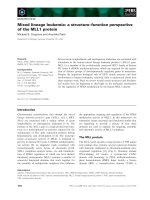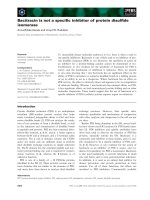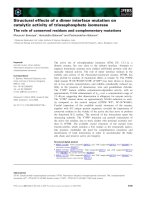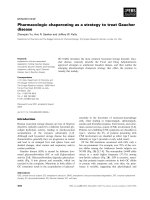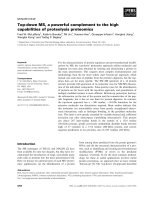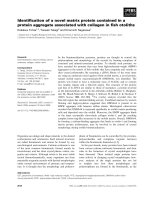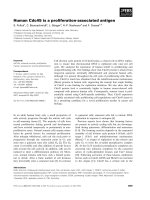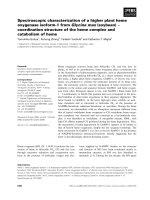Báo cáo khoa học: "Augmented Dependency Grammer: A Simple Interface between the Grammer Rule and the Knowledge" pptx
Bạn đang xem bản rút gọn của tài liệu. Xem và tải ngay bản đầy đủ của tài liệu tại đây (448.16 KB, 7 trang )
Augmented Dependency Gr~mm~r :
A Simple Interface between the Gr~.m~r Rule and the Knowledge
Kazunori MURAKI , ShunJi ICHIYAMA
C&C Systems Research Laboratories
NEC Corporation
Kawasaki-city,213 JAPAN and
Yasutomo FUKUMOCHI
Softwear development devision
NSIS Corporation
Kawasaki-city,213 JAPAN
ABSTRACT
This paper describes some operational
aspects of a language comprehension model which
unifies the linguistic theory and the semantic
theory in respect to operations. The
computational model, called Augmented Dependency
Grammar (ADG), formulates not only the
linguistic dependency structure of sentences but
also the semantic dependency structure using the
extended deep case grammar and fleld-oriented
fact-knowledge based inferences. Fact knowledge
base and ADG model clarify the qualitative
difference between what we call semantics and
logical meaning. From a practrical view point,
it provides clear image of syntactic/semantic
computation for language processing in analysis
and synthesis. It also explains the gap in
semantics and logical meaning, and gives a clear
computaional image of what we call conceptual
analysis.
This grammar is used for analysis of
Japanese and synthesis of English, in the
Japanese-to-English machine translation system
called VEN~S (Vehicle for Natural Language
Understanding and Synthesis) currently developed
by NEC.
Legato:
Crescendo:
Basic Idea
The VENUS analysis model consists of two
components, Legato and Crescendo, as shown in
Fig. I. Legato based on the ADG framework,
constructs semantic dependency structure of
Japanese input sentences by feature-oriented
dependency grammar rules as main control
information for syntactic analysis, and by
semantic inference mechanism on a object fields'
fact knowledge base. Legato maps syntactic
dependency directly to meaningful logical
dependency if possible, or maps it to language-
particular semantic dependency if two kinds of
dependencies do not coincide. The second
component, Crescendo, extracts a conceptual
structure about facts from the semantic
dependency structure through logical
interpretation on the language-particular
semantic dependency using knowledge based
inferences.
11 Input Sentence
Morphological
alysis i (Lexicon)
Word List
1P,
Dependency structure L
/
Semantic Dependency /
i Structure /
I
once tual~Str~ " / /
C p cture
IJ
[ Thesaurus
Analysis F ( Knowledge
Base
Conceptual Dependency
Structure
1
Fi~. I VENUS Analysis Module
198
A computational comprehension model for the
ADG is given in Fig. 2. Three different kinds
of information sources other than the lexicon
support language comprehension, and two
inference functions defined on them extract the
interpretation of input sentences. The top
level information is a language structure model.
The bottom is a logical(factual/conceptual)
interpretation model which determine the
possible logical relations between "OBJECTs and
THINGS".
The semantics located between the above two
models, which has not been clarified in any
paper. Suppose interpretalon is a process of
determining the relation between " OBJECTs and
THINGs ", the ordinary notion of semantics
allows us to determine words' semantics in
particular syntagmatic relations, but not
relational interpretation between concepts.
Language A
Syntactic/Semantlc~
process 1
/
Conceptual proc ISemantics /
Language B
Fi E. 2 Comprehension Model
The semantics here is defined as information
concerning the denotation of OBJECTs and THINGs.
It interprets the (semantic) relations between
them, and must be inducible from the raw
syntagmatic information. That is to say, it
may sometimes inherits such language particular
features as syntactic structure, wording,
culture. The structure representing semantics
may not be interpretable in terms of pure logic,
but may be represented linguistically.
I) The ADG defines syntactic dependency
structure, semantic dependency
structure, and descriminates the
semantic dependency from the logical
structure.
2) It functions as the interface between
syntactic dependency and semantic
dependency.
The notion of basically binary "dependency"
has a primary role to simplify the above
interface, just in the sense that either
syntactic or semantic inference recognizes
interpretable binary relation. The semantics in
the sense used here may not necessarily be
shared among languages, while facts are shared
among languages.
Legato built on the model is syntactic and
semantic analysis module which construct
directly semantic dependency structure from
surface structure. Crescendo is an engine to
eliminate non-logical part in semantic structure
and induces logical structure with pragmatic
information deduced from semantics.
~mantlo/Logical
Interpretation
Each word has its own meaning, sometimes
plural meanings. In this paper word meaning is
represented by a logical symbol called CONCEPT
SYMBOL. The symbol is a representation
primitive for fact knowledge base and internal
conceptual representation of sentences.
Semantic structure representation is also
defined on them, but it borrows syntagmatic
function called dummy symbols which never appear
in conceptual representation.
The above examples ~I, SEN2 share the same
meaning as shown in FACT1, except pragmatic and
temporal information. Ordinary analysis of SENI
produces subject-predicate-object syntagmatic
information, and further case interpretaion of
subject-predicate,object-predicate relations.
However this kind of case interpretation brings
into difficulties to select case marking
ambiguities such as GOAl or RESult for the above
object-predicate. SEN2 analysis produces
instantly REAson interpretation between two
nominals in terms of "REAson"-marking
preposition "because-of". This comparison
supports the case even a verb must be
interpreted in some case as a logical relation
and clarifies the standpoint to specify the ADG.
I. Factual(conceptual) information must be
independent of syntagmatic meaning as
well as independent of syntax.
2. Ordinary case marking strategy produces
anomaly because it dare to interpret
syntagmatic relations logically even if
those are purely syntagmatic existence.
3. Fillmore's case is not suitable for
conceptual representaion primitive for a
variety of syntactic and syntagmatic
structures.
On the other hand, syntax is a clue to
understanding of sentences. Syntagmatic
relations, in most cases, can
be
interpretable
as in FACTI for SEN2, and linguistic
information is a sole trigger for human to
recognize new notion or new word meaning in a
sentence.
199
SENt War resulted in disaster.
NOMINAL VERB . NOMINAL part-of-speech
subject pred object / grammatical f.
"REAson/j ~"~GOAI/// ordinary case
OBJect RESult semantics
SEN2 Disaster because of war
NOMINAL
P"~OMINAL
POST-NOMINAL modifier grammatical f.
DISASTER4 REAson 4 WAR
S~I War resulted in disaster.
WAR REAson DISASTER
"" REAson~ "~'~REAson2 /
F&CT1 WAR • REAson b DISASTER
ADG and usual case
semantics coincide with
factual meaning
CONCEPT SYMBOLs
ADG semantics
conceptual representation
for both SENI and SEN2
Comprehension of constructing factual
information is defined by two different levels
understanding; I LEGATO semantic analysis (as
shown in S~I, FACTI for SENI,2 respectively)
with direct correspondence to syntagmatic
relation, and 2. CRESCENDO factual (logical)
understanding as in a extraction process of
FACTI from SENt via S~I.
The symbols;
RF.J~onl,2
as in
S]~1,
are
called dummy relations in the sense that
REAson1(2) has no logical significance because
REAson1(2) holds in any combination of REAson
and other concept, while REAson in FACTI holds
in the special combination of concepts like WAR
with DISASTAR. They play a role to match
syntagmatic relation with semantics in terms of
syntax. These two processes analize the
pragmatic, modal, and temporal information which
is added into the factual structure to produce
the conceptual structure.
"Dependency" is 2nd idea, to figure out that
semantic (dependency) analysis of sentences is
executable at the same time of syntactic
(dependency) analysis. ADG employs dependency
framework in a different way from the ordinary
one. It deals with prepositions, postpositions,
case inflections, grsmmstical functions, copula
etc., as the functional features for relational
interpretation. For example, preposition in
English may not be a syntactic governor ('head'
in this paper) of its object phrase, copula "be"
in front of adjective modifies the syntactic
feature of the adjective as a syntagmatic head
predicate which allows it to have a dependent
marked as a subject, while adjective in itself
has a function of pre-nominal modifier. Namely,
most of the functional words are dealt like case
inflections. They add functional features to
words or modify their features.
The functional features map word-to-word
dependency to concept-to-concept semantic
dependency. The figure 3 explains the simple
interface mechanism. Functional features such as
SUBject, OBJect, BECAUSE-OF corresponds to
REAsonl, RF_~son2, REAson respectively. The ADG
syntactic dependency rules(see •s below) predict
those semantic relations using the functional
features and word syntax, and at the same time
they trigger fact knowledge base inference to
interpret Concept-to-Concept relations. A
fact(concept) knowledge base is composed of such
binary pieces as Ss or Cs. In this figure S and
C mean semantic knowledge dependent on
languages, and conceptual knowledge
respectively.
Word/Concept Function/Relation Word/Concept
• war subject result-in
S
WAR REAsonl REAson
• war object result-in
S WAR RF_~Lson2
RK&son
• war BECAUSE-OF disaster
C WAR REAson DISASTER
Fig. 3 Syntactic dependency r dummy/conceptual dependency
200
definition
DI. FEATURE describes morphological,
syntactic, semantic, and conceptual information
, and is used for describing the lexicon,
semantic structure, conceptual structure and ADG
rules. Feature is formalized as :
Feature
~ . ~Feature Value} .{ Context}
Dependency function, one of the syntactic
features for a particle , is described as
follows.
LD.LNULL ) .~A~ LH. {NULL1.
tA I
no word on the left depends on a
particle, it depends on no word on the
left
RD. INOM I. A RH. INULLI. A
it depends on NOMinal on the right
etc.
D2. CONCEPTUAL SYMBOL(C3) is a large set of
intensional symbols standing for meanings
conveyed by words. CONCEPTUAL SYMBOL includes
those symbols such as NOTION, COMPUTER, GIVE,
COLOR, BEAUTIFUL, SUP-SUB, PARTOF, AGT and so
on. CS is one of the features included in
FEATURE.
D3. THESAURUS is a system defined as a
subset of:
CONCEPTUAL S~L ~ x SUF-SUB(PARTOF)
relation
D4. FTABLE is a system defined as a subset
of:
CONCEPTUAL S~L x CONCEPTUAL/dummy F~LATION~
Relation symbols in PTABLE consist of 45
CONCEPTUAL relations except for SUP-SUB
relation, and dummy relations such as REAsonl,
REAson2, LOCI, etc. CONCEPTUAL RELATION is a
subset of CONCEPTUAL SYMBOL: AGT relation , OBJ
relation
.
POSSess relation, LOC
relation
and
the other
41
relations.
Relations are directed binary relations
including logical ones such as REAson, CAUSAL,
PARTOF, SUP-SUB, etc. and deep case relations
such as AGT, OBJ, LOC, etc., and several
language dependent dummy relations such as LOCI,
LOC2 ,CNTI, REAsonl etc.
The
THESAURUS
and the FTABLE, which is
described interms of semantic dependency and
conceptual information, compose the fact
knowledge base. The former forms directed
network called an abstraction hierarchy for
concept generalization.
CONCEPT SYMBOL
The CS(CONCEPT SYMBOL) differs from that of
Schank's primitives in many respects. The
number of CSs grows in proportion to the size
of vocaburary as human cultivates new ideas and
notions. The meaning of each CS is
intensionally defined by LambdaCS
COOCURR(CS,CSi,CRj). This model does not
require to explain the reason why these CSs
may be primitives and set up lexical rules for
mapping Sehank's semantic primitives to the
corresponding words. That is to say, human can
perceive the word concept only through observing
which CSs and CRs CO-OCURR with logical and
pragmatic functions. Each description of
C00CURR(CSI,CS2,CS3) in the world model, where
one C,$i can be interpreted as CR, specifies the
meaning LambdaCSi.
ADG rules are defined as feature-oriented.
DL. ADG: dependency rule for Legato.
(FEATUREI) + (FEATURE2) ~(FEATURE3)
Head
Selection
Feature Inheritance
Conceptual Relation Prediction
Triggering
Thesaurus/PTABLE
._g~mn-tio Dependency Construction
I)6. contextual rule for Crescendo.
IPA 1
*
i PA ;
PATH : FEATURE (dep/hed FEATURE)
(dep/hed :a dependency direction)
D7.
Network structure
is used for INTERNAL
REPRES~TATION: semantic dependency structure
and conceptual structure. Network St~eture is
defined as a subset of:
CONCEPTUAL 3YMBO~x~45
conceptual
relations,
dummy
relations }
I)8. Each lexical entry has its KEY and
CONTENT. The KEY consists of WORD spelling and
CS. The CONTENT is a set of FEATUREs . CS may
be one piece of those conceptual FEATUREs .
Atomic formula in FTABLE and THESAURUS
Knowledge Base consists of LEXICON,
THESAURUS and FTABLE.
The case grammar, as a basis of internal
representation, which is constructed with the
combination of binary case relations, fits the
dependency grammar very well, since both
dependency and case relation are basically
binary. The dependency analysis also correlates
to the atomic formula adopted for fact model
specification. The formula has the following
form, but not the ordinary predicate convention.
The formula tells only the fact that three CSs
(one may be CR) coocurr logically.
cooc~R ( c~sl , c.sj , c~ )
201
This convention also implies some order-free
calculation. The following example illustrates
this kind of flexible function.
$11 An Apple existed on the table.
APPLE LOCation TABLE - - -FI
LOC(APPLE,TABLE).
$12 The location of an apple was the table.
LOC
APPLE
TABLE
eq (TABLE, LOC of APPLE) - - - F2
TABLE
(LOC , APPLE) -
- - F3
$22 Tom processed data.
HUMAN PROCESS DATA - - - F4
PROCESS(HUMAN , DATA)
$22
The
agent of process was TOM.
(TOM is a process-or).
AGT PROCESS HUMAN
eq ( HUMAN, AGT of PROCESS) - - -F5
HUMAN ( AGT
, PROCESS ) -
- - F6
Many kinds of formula can be set up for
representing the above propositions In our
framework, the following unique representation
format resolves the higher order difficulties,
such as
FI&F3 : LOC(APPLE,TABLE(LOC,APPLE).
F4&F6 :PROCESS(HUMAN(AGT,PROCESS),DATA).
by using alternatives
COOCURR( APPLE, TABLE).
COOCURR(PROCESS,HUMAN,AGT).
COOCURR(PROCESS,DATA,OBJ).
Dependency grammar framework has been
augmented as follows:
ADG
funotlons
I. detects a possible pair of syntactic
head and its dependent based on their
FEATUREs,
2. predicts a set of permissible conceptual
relations between them, using their pro-
or post-positional features, phrase
structural features, case structural
features and so on,
3. triggers the knowledge base inference
mechanism using their CSs in their
conceptual information and the predicted
permissible relations,
4.
constructs their dependency structure
using their FEATUREs if the knowledge
base returns consistent semantic
interpretation; in other words, if the
consistent conceptual relation between
their CSs is found.
Legato Implementation
Legato is a bottom-up dependency analysis
engine (a kind of shift-reduce mechanism) based
on the non-deterministic push-down automaton 2
, which is extended by devising context holding
mechanism (context stack) to deal with
exceptional dependencies (to be mentioned
later).
The binary (augmented) dependency rule has a
structure shown in Fig. 2. If the focused word
(called FOCUS) and the word on the top of the
push-down stack (called Pd-TOP) have the
FEATUREs specified by the rule, a new HEAD with
the derived FEATUREs is created by the action in
the rule.
F O C U S + P d T O P ~ A C T I O N
feature feature actions
conditions conditions
for the focus for the push down
word stack top word
Fig. 4 Legato rule form
In the case of Japanese,
I. Japanese sentences satisfy the non-
crossing condition in syntactic
dependency relation.
2. Moreover, the syntactic dependency
relation coincides with the semantic and
conceptual dependency relation in most
cases.
However, the semantic dependency sometimes
doesn't coincide with the syntactic dependency.
In a worse case, even the non-crossing condition
does not hold. The sample sentences in Fig. 5
exemplify such a linguistic phenomenon.
The non-crossing condition does not hold
semantically in Ex. 2 and Ex. 3. Here in this
figure, the solid lines indicate a syntactic
dependency and the dotted lines indicate a
semantic dependency. The arrows run from the
head word to the dependent word.
A case of non-correspondence between
syntactic and semantic dependency is shown in
Ex. 2 (al & a2). although, w4 is recognized as
w3's syntactic head, the true semantic head of
w3 can be found among the words (wl and w2)
syntactically dependent on the word, w3. That is
the word, wl. Furthermore, the crossing of a2
and a3 violates the non-crossing condition.
The context stack is a small push-down stack
for keeping sub-context associated with the
dependent words , and it is attatched to the
202
newly generated HEAD in order to bridge the gap
between both kinds of dependencies. When
Legato creates a new HEAD from Pd-TOP and HEAD,
the context associated with Pd-TOP is stacked up
onto the context stack in the new HEAD. At the
same time, the semantic dependency is
constructed between Fd-TOP and HEAD if it is
permissible. Legato refers to the context in
the context stack if needed, and then constructs
the semantic dependency if the word which has a
semantic dependency relation to the word stored
within a context in the context stack can be
identified.
This enables the analysis mechanism to
easily deal with the sister dependency, which
cannot done with in the traditional dependency
grammar framework.
C~eseendo
implementation
The conceptual structure to be extracted as
the final result of the comprehension process
must be independent of the surface expression,
while the semantic structure given by Legato may
retain the inherited characteristics from the
surface expression in the source language. If
Ex. I
Ex. 2
Ex. 3
Fi~.
5
i
hu m an.
The sentence
• %
analysis ~ easy
I ,
*% t
q
i
i
computers
~A/2
the laboratory in W3 three W~ use
L
.
instead of car-S Robot make
t I' • -TI i
A ,A
I
.J
Examples of the gap between syntactic and semantic dependency
a. Input sentence
X is an ele m ent of the set A.
<ELe Men ~
~I ~LM2
J
b. Crescendo inference
CSs: 'ELeMent', 'SET', 'N A M E' , ('A' and 'x')
Conceptual Relations: 'N A M E' and 'ELeMent'.
dum my relations: 'ELMI , 'ELM2'
c. Contextual Rule
<ELeMent~ *XI ) . ~e~e~t
Fi~.6 Crescendo diaLra m
203
the surface sentences express the same concepts,
th?y must be organized into the same conceptual
dependency structure.
In the semantic structure example given on
the left in Fig. 6.b, the CS "ELeMent", which
usually has two meanings ( an object concept and
a membership relation concept), functions as an
object concept. It is reasonable, from a logical
point of view, to regard the CS as a relation
name in the conceptual structure , as shown on
the right in Fig.6.b because 'SET -ELeMent - X'
is easily deduced from the two propositions of
'ELeMent -ELM2 - X' and 'ELeMent - ELMI - SET'.
That is to say, the two sentences, like "The set
A includes X" and "X is an element in the set
A," must have the same conceptual structure.
Crescendo controls this kind of logical
deduction neccessary for concluding the
conceptual structure from the semantic
structure. Besides conceptual and logical
inference rules, it has causal inference rules
among the facts for determing consistent causal
chains.
Figure 6.c shows an example of the logical
inference rules. It infers the right conceptual
structure in Fig. 6.b from the left semantic
structure. The knowledge based inference also
assures the consistency of the deduced
conceptual structures.
Conluding Remark
This paper has introduced a language
comprehension model ADG to determine linguistic
and semantic structures in sentences with a
simple binary operation framework. The proposed
dependency structure analysis engine (Legato)
and the conceptual structure extraction engine
(Crescendo) have been implemented. The ADG
succeeded in constructively formalizing
syntactic specification and semantic
interpretation, using the knowledge base of a
set of conceptual relations and the inference
mechanism on it, defined only by simple binary
operations.
Legato and Crescendo were incorporated in
VENUS
Japanese-to-English machine translation
system. The experiments have proved its
operational efficacy, fitness and Justification.
The ADG points out anomaly in usual case
systems, and resolves it by introducing the
concept of dummy relation which can not and must
not be interpreted logically. This extension
puts the semantics of a linguistic theory in
the correct position.
References
I. Gaifman, H., "Dependency System and
Phrase Structure Systems, "Information
and Control 8,304-337(1965).
2. Aho, A.V., Hopcroft, J.E. and Ullman
,J.D., "The Design and Analysis of
Computer Algorithms," Addison-Wesley
Publishing Co.(1974).
204
